On September 10th and 13th Fathom Events is holding 35th anniversary screenings of Star Trek II: The Wrath of Khan Director’s Cut in theaters across the USA. TrekMovie took the opportunity to chat with Wrath of Khan director and (uncredited) screenwriter Nicholas Meyer about the event and his experiences making the film.
Writing for Star Trek’s troika
Let’s start talking about this upcoming Star Trek II event in theaters. Obviously, a lot of fans have Wrath of Khan on home video or streaming, so what is special about seeing it on the big screen?
I am happy to answer that by quoting my father, who said to me many years ago that watching a movie on TV is like kissing over the telephone.
Much has been said about classical influences on the two main characters, with Kirk as Horatio Horn blower and Khan as Ahab. Were there classical archetypes or characters that were part of your inspiration for the other major characters, in writing and directing for Leonard Nimoy’s Spock and DeForest Kelley’s McCoy?
Not really. I think that the troika of Kirk, Spock and McCoy had been identified pretty much by Harve and their characters were fairly established – and this is painting with a broad brush – but McCoy was the bleeding heart liberal and Spock was the logician, perhaps to the point of being somewhere on the spectrum, and Kirk was the mediator between the two of them. In that sense, they were all very easy to write for. I simply put my own stamp on the dialog, or at least I like to think I did. Spock definitely was reminiscent of Sherlock Holmes in my way of thinking and in fact in Star Trek VI I had him claim descent from Holmes.
Dealing with Gene’s objections
One of the big changes between Star Trek: The Motion Picture and Wrath of Khan was that Gene Roddenberry was no longer in charge. Harve Bennett was the executive producer, but Gene was still a consultant. Can you talk about what your interactions with Gene were like?
This is an interesting question for me because it reveals the fallibility of memory. When asked this question before about Gene Roddenberry, my recollection was that we didn’t have much interaction. I was introduced to him and met him and that was it. He certainly had nothing to do with the actual filming or editing of the movie. However, some years ago I was back at my alma matter, the University of Iowa, which is the repository of my papers, and an exhibition was set up in which, to my astonishment, were displayed a series memoranda between myself and Gene Roddenberry that went on and on about the script and his many issues with it.
This exchange, which in candor was not always entirely pleasant, had been completely erased from my memory until the material fact of it was brought to my attention. I was very, very surprised. The Star Trek that Gene created became, I think, ultimately a bottle into which many people subsequently poured their own vintages. The bottle never changed, but the various writers and directors and so forth who contributed to what people call “the franchise” – word I am leery of – they did their own thing with it. And I was perhaps the first person in that long line. And Gene was understandably – but not always correctly – distressed at a new and different vintage going into that bottle. And I think the tenor of those memoranda between us was focused on his objections to what I was doing differently.
I was not at all averse to conflict. I did not, and do not, believe in the perfectibility of man. And although I think the Star Trek aspiration and inter-ethnicity are all for the good, I was still interested in people that to me were recognizably human, and that included being either petty or vain or having different kinds of emotional agendas as we have since the beginning of time. I think that Gene took very grave exception to that notion. The 23rd century is a place where everybody is going to get along and Starfleet was not a militaristic organization. Maybe it was like the Coast Guard and I had a darker view.

Producer Gene Roddenberry with director Robert Wise on set of Star Trek: The Motion Picture – for Wrath of Khan he was relegated to writing memos
Directing Shatner
At a recent event in Hollywood you told a story about how early on you got a call from Harve about how Shatner hated the script and you had this real intimidating meeting, but eventually you and Harve sorted it out. I am curious – what were these issues that at the time seemed like such a big deal for Bill?
What I remember is my bladder kept filling up and I had to keep excusing myself and Bill was saying “Are you alright, what’s wrong?” I had to make something up about indigestion, but it was rage and humiliation transmuted into urine. Basically, this comes from this being the second movie I ever directed and my first real experience writing for a star, and it was coupled with what is not a native analytic ability to break things down into bite-sized components. Simply put, as translated by Harve – Bill wanted to be the first man through the door. He was Captain Kirk. He is the hero. He shouldn’t appear to be at a loss unless it is for a meaningful dramatic purpose. And I am not sure I think of Bill as a particularly vain person personally, but he was very, very protective of that character as embodied by himself. And he didn’t want Kirk looking or being less than Kirk.
One of the notes was that I had specified in the screenplay how old Kirk was and this was a movie that put Bill in an uncomfortable place because the story is about age and Kirk being depressed and Kirk not being at the top of his game and having to recover all of that. That is the arc of the character. And I remember Bill asking, “Do we have to specify Kirk as this age?” And I thought no you don’t and there was a double point in that once an actor plays a role that confesses that his age is x, then it is hard for him to audition for a role that is younger than x, because people see you as what you committed to. I understood this. And once I understood what his objections were, it was not very hard to rewrite his scenes in such a way that accommodate everything that he was upset or frantic about. And I guess because he is not a particularly analytic person, he came in very strong and very dramatic but as Harve pointed out afterwards, his issues were very small and mainly related to himself and not the script and were easily addressed. In fact, I think I addressed it in about 12 hours.
So, the specific age bugged him, but he didn’t mind the arc you introduced of Kirk going through a mid-life crisis?
Well, he had to get his head around that. I think at the end of the day what he bought into were the dramatic possibilities of the role that were on offer and that I think ultimately was the catnip that allowed him to swallow the whole concept.
You talk about this intimidating meeting, but you have also talked about how you would wear Shatner down on set with multiple takes to get him to act naturally. So, I am wondering: how did you go from the guy who had the pee scared out of him to having the chutzpah to drag Bill through take after take? Did you have any issues as a young guy in his thirties to get the authority needed to direct these veterans?
I think the tradition of movies is that a lot of directors start when they are very young. Steven Spielberg began by directing Joan Crawford, if you can get your head around that one. Yes, it does take a certain amount of chutzpah to make your ideas or your wishes known to actors who have more seniority and arguably more experience over yours. I think by the time I was getting into scenes with Bill, his own intelligence and talent were making increasing sense of the role. And as our shooting progressed more or less smoothly apace, there was a sort of unspoken trust in each other, and certainly with me in myself, that gathered.
And when I was doing a lot of takes with him, I didn’t announce what I was doing. I had help from the cameraman who would say, “Oh the focus is off,” or the sound man who would say, “The sound wasn’t good.” And I would say, “OK, let’s go again.” So, I think he was not attributing – at least not in the beginning – what I was doing. I would occasionally give direction, “Bill, make it smaller.” I was always about making things smaller. I think it was one of his most subtle and nuanced performances. Like when he tells Khan the code for the vessels and he says “Here it comes” and there was a kind of sneer and a warning in the tone and I was “Let’s take that out, he is smart, he is going to know you are up to something.” It took a while to get there.
Funnily enough, Ricardo Mantalban as Khan also started out very, very big. Huge! I kept tamping it down and tamping it down. We were talking before about the difference between television and a movie. Well with a movie those faces are really large. One reason to go see the movie is that watching it on TV is like looking at a painting with the wrong frame around it. And the smallest twitch, the most subtle flicker of an eyelid conveys so much. If you watch it on TV you may not catch it. So, Bill had been doing things mainly on television and I was thinking movies.
The limits of the bridge
One of the notable things about Star Trek II is how much of It takes place on these two bridge sets, but I understand you were not a fan of shooting on the bridge. Patrick Stewart said when he first saw the bridge of the Enterprise he immediately understood it, seeing it as Shakespearean stage. Would you really have wanted to do more off the bridge? Aren’t those intimate settings part of what makes the film work?
First let me say that I do believe that a lot of really good film acting takes place in intimate spaces. There are obvious exceptions, like Lawrence of Arabia for example. But closed-in spaces are very friendly to actors. I totally get what Patrick is talking about when he likens the bridge to an Elizabethan apron. I get that. On the other hand, from a purely cinematic point of view, and I was always approaching as film and not television, the bridge always limited. I always wondered about the other parts of the ship, which I think in Star Trek VI you get to see other parts of the ship – where the crew sleeps, where the galley is and so forth. And as a filmmaker committing coverage in 360 degrees is very tedious.
So, I don’t think what I am saying is in particular or total disagreement with Patrick’s observation. I just think he is looking at it as an actor and moreover as a stage actor and I was looking more of it as a filmmaker and as a film director.
So why didn’t you write in more scenes off the bridge?
Take a look at the budget.
So, this is one of your examples of how limitations make art?
Yeah. You have to turn your weaknesses into strengths. You have to make what you don’t have do – you have to turn things inside out. My model for this was always the Lawrence Olivier Henry V movie, which was made for about fifty cents during World War II and largely set in an Elizabethan theater.
Robert Sallin – unsung hero of Star Trek II
Last time we chatted I asked you about unsung heroes for Wrath of Khan and you said you would have to get back to me. I actually have a specific person I have in mind which is producer Robert Sallin, someone who many fans may not know because he was only involved with this movie. Is he one of these unsung heroes and what can you tell us about his contribution?
I can tell you a fair amount. Bob Sallin is an enormously intelligent and tasteful guy who for many years had his own company and made commercials. He was a friend and classmate of Harve Bennett’s at UCLA and they took this opportunity to work together. It was Bob Salin who suggested the cinematographer Gayne Rescher to me and Gayne Rescher was absolutely brilliant. He was the cinematographer on A Face in the Crowd, which is probably the greatest movie people have never seen, starring Andy Griffith of all people and directed by Elia Kazan. And I think he also recommended the editor, Bill Dornish.
He also had a more sophisticated visual sense than I did after having only made one movie. I remember that Kirk’s entrance was reshot. He was backlit like a rock star when he comes out. This was at Bob’s instigation. And throughout the movie he made many contributions along similar lines. And then at the end when I – for reasons which may or may not have been proved sound – was very upset at the notion of filming the coffin on the planet, Bob went up to San Francisco at the Botanical Gardens and he shot it. So, his contributions are significant.
Wrath of Khan back in theaters September 10th & 13th
The 35th anniversary screenings of Star Trek II: The Wrath of Khan Director’s Cut with an exclusive introduction by William Shatner will be held at theaters across the country on September 10th and 13th. Get your tickets now before they sell out by visiting fathomevents.com.
Here is the official trailer for the event:
We were asked by Carusele to promote The Wrath of Khan 35th Anniversary screenings, sponsored by Fathom Events. Although we have been compensated, all opinions are our own.


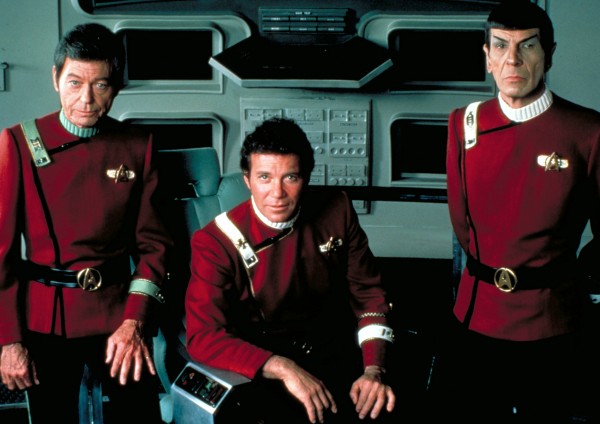
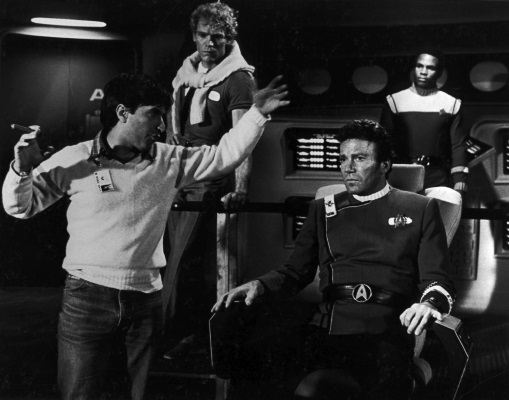
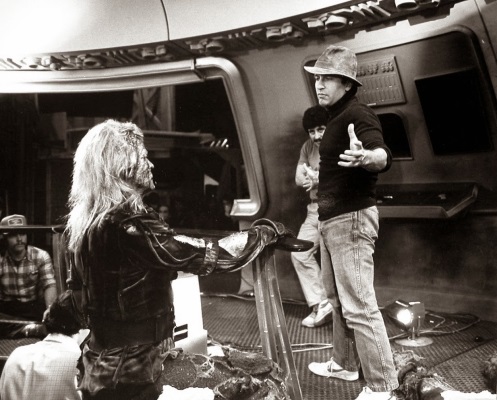
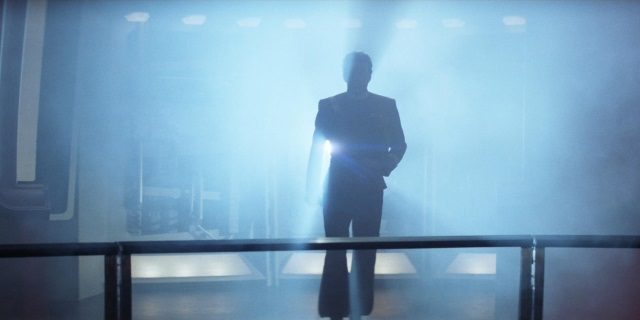

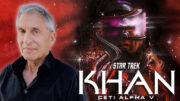
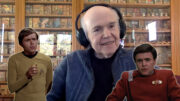
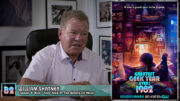
A thoughtful, interesting guy. His book is very good and contains a lot of these anecdotes.
Nick being a part of the “Star Trek: Discovery” team is one of the main reasons I think the show will be a smashing success.
Great interview!!
Here, here. I second that. I am in on paying for Star Trek Discovery because it has Nicholas Meyer on the credits.
Meyer hasn’t publicly spoken about DSC in a while, though, which is frankly making me a little nervous.
Agreed. I was most worried when I heard the actor was criticized by some Voyager Director where you immediately thought Nicholas Meyer would step in. If I was CBS putting this kind of $$$ I’d demand Nicholas Meyer on the site all the time. I mean Star Trek II – “From hells heart, hell’s heart i stab at thee-” “HEY, EXCUSE ME! NO HELL ON THE SET, THAT’S NOT GENERIC ENOUGH FOR THE 23RD CENTURY”.
It appears that Akiva Goldsman is far more active at participating in ST:Discovery than Meyer and that makes me VERY nervous.
Goldsman’s done some solid TV work. He seems better suited to it than movies.
Ugh, I’ll say. Wasn’t he a backer of Lindelof’s [/s] idea to reiterate Khaaaannn! in ST:ID?
Lindelof’s “great” [/s] idea
Oh, for an edit function
Hmmm, or proofreading before I post, oops.
Wow. Meyer’s recollections about working with Bob Sallin are very generous, given what he wrote about him in “The View From the Bridge.” Sallin openly derided Meyer’s abilities as a director in the Kobayashi Maru scene, accused him of being willing to “run over his own mother to get his way” when Meyer balked at filming the casket scene, and badmouthed him for his supposed lack of postproduction knowledge in the pages of Cinefantastique. As so often happens it wasn’t a great working relationship between them (or with Harve Bennett, who never worked with Sallin again), but it did result in a great film.
It is probably a combination of wisdom with age and perspective viewed through the lens of time.
Probably. A friend of mine read a recently published Harlan Ellison biography and reports that even SF’s last angry man is having second thoughts over some long-nurtured grudges. Age will do that; don’t I know it.
Yeah, life’s too short for big grudges. I remember some of the epic arguments I used to have with people in the earliest days of this site when I was 30-ish. Now I’m in my 40s and I regret those fights.
It was a definite lack of post knowledge on Meyer’s part, which he admitted even at the time. TIME AFTER TIME’s VFX were handled by one of the main guys fired off TMP, Richard Taylor, but they were minimal and I don’t think Meyer had a ton of input there outside of making it more about the sounds than the visual during the time trip.
I think Sallin got a bad rap at the time, and it is strange because if you read MAKING OF ST II, it is clear he was the closest thing to Bob Justman on the lot.
He sure did admit it. IIRC in the CFQ article he said something to the effect of “We didn’t know what the f**k we were doing,” which was what Sallin, as producer, took great exception to, angrily writing to the magazine in rebuttal that he, at least, most certainly did know. The exchange stuck with me all these years mostly due to my surprise that the two would go after each other so vehemently at a time when even Pauline Kael was praising the results of their collaboration.
Meyer has always been modest and self-deprecating about his own talents, and has often expressed sincere regret over not handling his strained relations with Gene Roddenberry better, so I’m not surprised that he would use this opportunity to give Bob Sallin credit in spite of the bad blood between them. I think that’s pretty admirable, actually.
That first pic of Shat, Nimoy and Kelley. I love the fact the Enterprise had cassette holders screwed into the walls of the main bridge behind Kirks head. I wonder what music they listened to on the bridge. Probably not The Beastie Boys.
Probably not; at least it wasn’t 8-track. And TWOK was a notoriously low-budget affair–what was up with those grocery scanners on the Abrams bridge?
Grocery scanners in the Target cosmetics aisle, you mean. The brightness and glare-y-ness of it is the opposite of what you want in a functional environment.
Meyer once said he thought he spent fifty grand just touring the bridge set, with all the added blinkies, but I keep thinking they probably just used what was already there from TMP,just in a less Wise-like, more vivid way. Certainly swapping out the RP film in favor of video monitors was the right call (and nobody seems to know why they didn’t go that route on TMP, going by RETURN TO TOMORROW’s discussion of this. Disney did it at the same time for THE BLACK HOLE and the video playback worked fine.
Definitely going to have to pick up RETURN TO TOMORROW eventually.
You may find issue with how RtT is edited (or not edited, really, because the interviews overlap and repeat info an awful lot, making for some redundancy), but there isn’t too much that contradicts, and only a small handful of outright errors (nearly all of which are mis-recollections on the part of the interviewees, like Jon Povill confusing Steve Bochco with Bill Norton when discussing who was first hired to write IN THY IMAGE.)
They really should have called it ‘Everything You Wanted to Know about TMP But Were Afraid to Ask (except some real perspective from the original VFX Bosses, who are absent from this book)’
That’s where I think you got bigger bang for your buck with ST: II bridge. When you saw Kirk on the bridge, you had blinking computer read outs and non commissioned officers monitoring the ship status. ST:2009 spends millions more and it’s Kirk and a bright grey door.
I didn’t mind all the blue and white in ST2009. What I DID mind was those feckin bright lights pointed into everybody’s eyes, even the audience’s.
Every officer on that bridge would get migraines, man. Or maybe they would have to wear special contact lenses. Highly illogical.
Super fascinating. Interesting hearing him discuss filming, especially his remarks about William Shatner. Shatner always seems really complicated when you hear people talk about him but Meyer sort of breaks that down, Very interesting.
Yes, Meyer worked magic. Because in the final cut when ShatKirk says, “Here it comes” he did just the right thing. Slightly wry, very understated.
Good interview but shame you did not or could not ask about the 4K UHD HDR scan Meyer supervised last year & when or if indeed it will ever be sold to the great unwashed public (or indeed does it even form the basis of this screening!). Also if you could follow up with Meyer how about a question on if he also did a 4K UHD HDR scan for ST6 please!!!
With all the grain in TUC from shooting Super 35 and doing the finish optically back then (you had to do an optical blowup to get a release print, basically like a double-dupe, which you NEVER want to do with VFX, which are already going a generation down in most instances), it didn’t look that good even in the best conditions. Not sure if a higher rez scan is going to do much besides discover more imperfections or graininess — and while I like grain more than the waxy look of DNR, TUC had too much of it, especially on the godawful 70mm print I accidentally saw opening day, which was so dark that the Kirk McCoy prison bunk scene was utterly black, like viewing at a drive-in.
I love the look of super 35 film. The cinematography in VI is excellent, I really like the contrast shots and it’s interesting that Meyer could use fast lenses and capture really detailed shots. vI is my favourite Trek movie, I can never understand the lack of love for it.
https://theasc.com/articles/star-trek-50-part-viii-undiscovered-cinematography
Spock’s pride and Kirk’s prejudice are convenient rungs to hang the plot upon, but they’re essentially dishonest representations of the characters, and with a story like this that should have some genuine resonance (as would have been the case if Kirk & McCoy had happened into old antagonists while on Rure Penthe — something the original writers had included — giving some context and history to their stay there, along with ticking off plot boxes), such dishonesty simply infuriates.
I’ve gotten to a point where I can watch TUC occasionally all the way through, but it doesn’t ever feel like it has its heart or its head in the right place most of the time (say what you will about TFF – for myself it is the one of the three good ones, along with TMP and TWOK — but it does have its heart in the right place throughout, even if its brain is often as absent as the half-Vulc’s in SPOCK’S BRAIN.)
As for S35 … anamorphic looks GOOD, so S35 takes away one of the main appeals of widescreen filmmaking. Could say the same for early digital, but at least they’re starting to frequently use old old lenses with some interesting aberrations that offset the disturbing perfection and clinical detail of high-rez digital capture. High res film capture seems to have a pleasant quality, whereas digital without blunting comes off like a medical exam at times.
Kmart, “Spock’s pride and Kirk’s prejudice are convenient rungs to hang the plot upon, but they’re essentially dishonest representations of the characters….”
I agree, along with some of the other hooey, like the prejudice of the other officers toward the Klingons. Jiminy, if you hate ’em, hate ’em when you’re off duty and out of the hearing of the CO and XO! Hard for me to stomach Starfleet officers acting that way. They’re explorers of new worlds, not yahoos.
You are right on about TUC feeling forced; it was very much a slave to the “let’s make this right” ethos floating around after Trek V, which time continues to show – and yes, it has its contrivances – is pure Trek.
all of that was covered in my interview with him at the start of the summer and is linked in the article.
https://trekmovie.com/2017/05/30/interview-nicholas-meyer-on-why-star-trek-the-wrath-of-khan-endures-after-35-years/
I’m looking forward to seeing it in theater again. Sincerely hope the DC gives Judson Scott credit for his role.